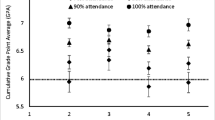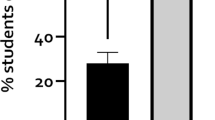Abstract
In India, a single national level entrance examination for admission to undergraduate and postgraduate medical courses has been introduced. This is largely an effort towards alleviating financial corruption in admission process, improving logistics and ease of examination for students, and resource-efficacy in conduct of examination. Unfortunately, the possible educational impact of such single high-stakes examination has not been overtly discussed. A major handicap in doing so is the lack of documentation and analysis of our own experience with multiple entrance examinations over many years. One adverse aspect of a single high-stakes examination, especially the Postgraduate entrance examination, is that the students’ learning priorities get redefined to being ‘examination-oriented’ rather than ‘competency-development oriented’. Hence, we must draw lessons from admission processes in other countries that have gone through similar course. Two key effective practices in these countries include giving weightage to prior academic performance, and use of a combination of some form of cognitive testing, aptitude testing and non-cognitive assessment, for taking selection decisions. It is prudent to modify our existent examination processes utilizing the same principles. There is a need to improve the formative assessments and the end-of-training certification examinations, and possibly also include them as inputs for the admission process.
Similar content being viewed by others
References
Prideaux D, Roberts C, Eva K, Centeno A, McCrorie P, McManus C, et al. Assessment for selection for the health care professions and specialty training: consensus statement and recommendations from the Ottawa conference. Med Teach. 2011;33:215–23.
Powis D. Selecting medical students: An unresolved challenge. Med Teach. 2015;37:252–60.
Siu E, Reiter HI. Overview: what’s worked and what hasn’t as a guide towards predictive admissions tool development. Adv Health Sci Educ. 2009;14:759–75.
Cleland J, Dowell J, McLachlan J, Nicholson S, Patterson F. Identifying the best practice in the selection of medical students (literature review and interview survey). 2012. Available from: http://www.gmc-uk.org/Identifying_best_practice_in_the_selection_of_medical_students.pdf_51119804.pdf. Accessed February 02, 2016.
Mercer A, Puddey IA. Admission selection criteria as predictors of outcomes in an undergraduate medical course: A prospective study. Med Teach, 2011;33:997–1004.
McManus IC, Powis DA, Wakeford R, Ferguson E, James D, Richards P. Learning in practice Intellectual aptitude tests and A levels for selecting UK school leaver entrants for medical school. BMJ. 2005;331:555–9.
Wright SR, Bradley PM. Has the UK Clinical Aptitude Test improved medical student selection? Med Educ. 2010;44:1069–76.
Selection committee, Directorate of Medical Education, Government of Tamilnadu. Prospectus for admission to MBBS/BDS courses 2016-2017 session. Chennai. Government of Tamilnadu; 2016. Available from: http://www.tnhealth.org/online_notification/notification/N1605308.pdf. Accessed September 9, 2016.
Armed Forces Medical College, Pune: MBBS Admissions-2016. Available from: http://afmc.nic.in/PDFfiles/MBBS%202016%20interview%20list.pdf. Accessed October 12, 2016.
Christian Medical College. Revised supplementary bulletin MBBS admissions 2016. Vellore; 2016. Available from: http://admissions.cmcvellore.ac.in/linkeddata/uploads/MBBS%20BULLETIN%202016%20Dated% 2015%20Aug%202016.pdf. Accessed September 9, 2016.
Wilson IG, Roberts C, Flynn EM, Griffin B. Only the best: medical student selection in Australia. Med J Austr. 2012;196:357–61. Available from: https://www.mja.com. au/system/files/issues/196_05_190312/wil11388_fm.pdf. Accessed February 26, 2016
McGaghie WC. Assessing readiness for medical education. Evolution of the Medical College Admission Test. JAMA. 2002;288:1085–90.
Julian ER. Validity of medical college admission test for predicting medical school performance. Acad Med. 2005;80:910–17.
Laidlow A, Hart J. Communication skills: An essential component of medical curricula. Part I: Assessment of clinical communication: AMEE Guide No.51. Med Teach. 2011;33:6–8.
Tamblyn R, Abrhamowicz M, Dauphinee D, Wenghover E, Jacques A, Klass D, et al. Physician scores on a national clinical skills examination as predictors of complaints to Medical Regulatory Authorities. J Am Med Assoc. 2007;298:993–1001.
Urlings-Strop LC, Stegers-Jager KM, Stijnen T, Themmen APN. Academic and non-academic selection criteria in predicting medical school performance. Med Teach. 2013;35:497–502.
Powis D, Hamilton J, McManus IC. Widening access by changing the criteria for selecting medical students. Teaching and Teacher Education. 2007;23:1235–45.
Kreiter CD, Yin P, Solow C, Brennan RL. Investigating the reliability of the medical school admissions interview. Adv Health Sci Educ. 2004;9:147–59.
Eva KW, Rosenfeld J, Reiter HI, Norman GR. An admissions OSCE: the multiple mini-interview. Med Educ. 2004;38:314–26.
Government of India. The Gazette of India, Extraordinary Part III, Section 4. New Delhi. 27 December 2010; 342. Available from: http://www.mciindia.org/tools/announcement/2010Dec27_49068_Gazette_Notification_NEET-UG.pdf. Accessed February 26, 2016.
Government of India. The Gazette of India, Extraordinary Part III, Section 4. New Delhi. 27 February 2012; 41. Available from: http://www.mciindia.org/tools/announcement/2012Feb27_62051_Gazette_ Notification _NEET-UG.PDF. Accessed February 26, 2016.
Medical Council of India. Final Schedule for All India Quota (NEET) UG Counseling 2013 (Annexure to letter No. V.11017/1/2009-MEP-1 dated 24th June 2013). Available from: http://www.mciindia.org/tools/announcement/2011_FinalCoreSyllabus_NEET-UG/NEET_UG_Counselling.pdf. Accessed February 26, 2016.
Kabir A. Judgement in the Supreme Court of India (Christian Medical College Vellore and Others versus Union of India and Others. TC (C) 98 of 2012. Available from: http://www.mciindia.org/tools/announcement/judgment-neet180713.pdf. Accessed February 26, 2016.
Ananthakrishnan N. Saying no to NEET is certainly not neat. Natl Med J India. 2013;26:250–51.
Singh T. Was it wrong to discard NEET? Natl Med J India. 2014;27:119–20.
Gupta N. Nagpal G, Dhaliwal U. Student performance during the medical course: Role of pre-admission eligibility and selection criteria. Natl Med J India. 2013;26:223–6.
Pardeshi G. MCI and NEET-PG: Understanding the point of view of medical graduates. Natl Med J India. 2012;25:314–5.
Gliatto P, Leitman M, Muller D. Scylla and Charybdis: The MCAT, USMLE, and degrees of freedom in undergraduate medical education. Acad Med. 2016;91:1498–1500.
Anand AC. PG entrance for dummies (Are you looking for a postgraduate seat?). Natl Med J India. 2011;24:38–42.
Case SM, Swanson DB. Constructing written test questions for the basic and clinical sciences. 3rd Ed. Philadelphia. National Board of Medical Examiners; 2002. Available from: http://www.nbme.org/PDF/ItemWriting_2003/2003IWGwhole.pdf. Accessed September 15, 2016.
Singh T, Anshu. Internal assessment revisited. Natl Med J India. 2009;22:82–4.
Medical Council of India Regulations on Graduate Medical Education 1997. Available from: http://www.mciindia.org/Rules and Regulations/Graduate Medical Education Regulations 1997. Accessed May 31, 2016.
Konopasek L, Norcini J, Krupat E. Focusing on the formative: building an assessment system aimed at student growth and development. Acad Med. 2016: 91:1492–7.
Singh T, Anshu, Modi JN. The Quarter Model: A proposed approach for In-training assessment of undergraduate students in Indian medical schools. Indian Pediatr. 2012;49:871–878.
Andlosek KM. Improving the medical student performance evaluation to facilitate resident selection. Acad Med. 2016: 91:1475–9.
Katsufrakis PJ, Uhler TA, Jones LD. The residency application process: Pursuing improved outcomes through better understanding of issues. Acad Med. 2016;91:1483–7.
Association of American Medical Colleges, Medical Student Performance Evaluation Task Force. Recommendations for Revising the Medical Student Performance Evlauation (MSPE). Washington DC. Association of American Medical Colleges; 2016. Available from: https://www.aamc.org/download/470400/data/mspe-recommendations.pdf. Accessed October 8, 2016.
Author information
Authors and Affiliations
Corresponding author
Rights and permissions
About this article
Cite this article
Singh, T., Modi, J.N., Kumar, V. et al. Admission to undergraduate and postgraduate medical courses: Looking beyond single entrance examinations. Indian Pediatr 54, 231–238 (2017). https://doi.org/10.1007/s13312-017-1036-z
Published:
Issue Date:
DOI: https://doi.org/10.1007/s13312-017-1036-z




